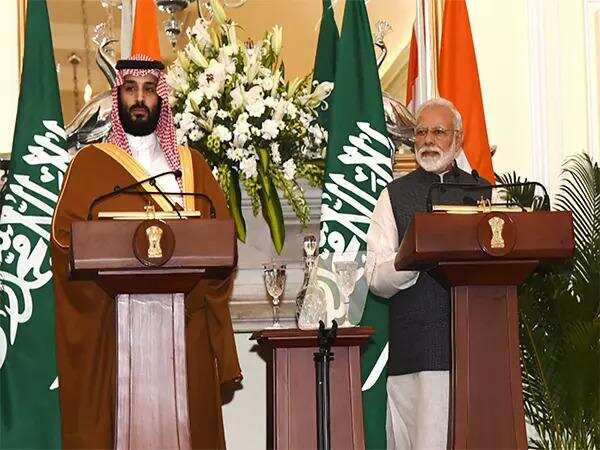Strengthening the Indian Scotland Arc in an era of corridors, competition and global reorientation

In a major reciprocating gesture, Prime Minister Narendra Modi began a two-day visit to Jeddah at the invitation of Saudi Crown Prince Mohammed bin Salman. The visit comes nearly 19 months after the Crown Prince visited New Delhi during his visit to India’s G20 president in September 2023. This is the third visit to the Kingdom after 2016 and 2019, the sixth international visit this year, and the fifth visit since the Israel-Hamas War in October 2023, the fifth visit to the Middle East, and since the outbreak in October 2023, it is a certain prefecture-level institution, which is certain, the following is certain, the following is certain, the following is certain, the following is certain, the following is certain, the following is certain conflicts in the middle. The country’s power shift into the ongoing Israel-Hamas War-PM Modi’s visit marks a new diplomatic push to deepen the Indian Suni strategic arc.

Schedule is not more critical. As the order of global ventilation and strong competition intensifies, especially in the U.S.-China trade war, countries such as India and Saudi Arabia are increasingly seen as stable forces that can balance the consistency of competition. For India, Washington’s recent tariff rate hikes (main imports to China’s main imports up to 245%) provide new economic opportunities for India, especially as Beijing calls on New Delhi to enhance bilateral trade. Meanwhile, India is encouraging the United States to flow into its production and investment to India, using space as a viable alternative to China. As far as Saudi Arabia is concerned, it is playing its diplomatic balance, establishing deep ties with the United States, and also welcomes China as a mediator in Saudi-Iran Détente.
The revival of the Central India-European Economic Corridor (IMEC) is a key focus in this complex geopolitical undercurrent interaction. India maintains the momentum of IMEC by signing an intergovernmental framework with the UAE, encourages private players like the Adani Group to establish connectivity through the Haifa port and launches the India-Metitraian Initiative (IMI) with European partners. In this case, Saudi Arabia’s role is essential in transforming the vision of IMEC into reality, and Modi’s visit may be a platform to advance an intergovernmental framework similar to Riyadh.
The visit is also expected to revisit the bilateral agreements in 2019, many of which have not yet been fully implemented. For example, the Crown Prince invested $100 billion in India, which is yet to be realized. Furthermore, given the increasing threat to critical infrastructure, especially those raised by non-state actors in the Red Sea, both countries may explore ways to embed IMEC in a broader framework for security cooperation. Existing national security advisory-level dialogues may be expanded to include strategic infrastructure protection, especially within the scope of IMEC.
Furthermore, due to global chaos, Modi’s outreach highlights India’s larger vision for global South solidarity. Saudi Arabia’s role in shaping a new world order will be attracting attention as the Middle East prepares to host key diplomatic visitors, including President Trump’s expected visit to Riyadh in May. It is time to invite Saudi Arabia, a major country in the Middle East, to consider joining India’s Mahasagar initiative, aiming to establish a cooperative maritime arc in the Indo-Pacific and western Indian Oceans. He had previously visited Mauritius, Thailand and Sri Lanka and Africa for publicity, and then joined the initiative, followed by Saudi Arabia, which symbolized India’s intention to connect the Gulf to Mahazakar under Saudi Arabia’s leadership.
Furthermore, India and Saudi Arabia are increasingly embedded in overlapping regional security complexes driven by the integration of national interests, growing energy interdependence and a desire for regional stability. In the Middle East, both countries have made in-depth investments in the stability of the Gulf – Indiana is a residence for net energy importers and large numbers of diaspora, of which about 9.5 million live only in Saudi Arabia, while the Kingdom of Saudi Arabia is a regional anchor line that serves as a regional anchor line, including Iran’s delicate issues, including Iran’s problems and security scripts, including.
In the Indo-Pacific region where Indian strategic calculations develop in China’s confidence, Saudi Arabia’s eastern participation following its “East” policy is growing – through investment, port partnerships, and interest in multilateral groups like Brics+, such as Brics+ – it is firm in the maritime communities extending in India. Globally, their position as emerging powers seeking greater autonomy in a turbulent world order aligns their views on IMEC, food and energy security, and the corridors of economic and peace, and responds to non-state threats such as piracy and terrorism. In this case, the two countries are not only bilateral partners, but also increasingly common stakeholders, strategic buildings that shape the broader arc from West Asia to the Indo-Pacific and beyond. Therefore, their active participation in global initiatives, their respective regional leadership roles, and the calibrated multilateral engagement reflects how India and Saudi Arabia become responsible MENA.
Essentially, this visit is about unfinished business and turning intentions into actions. While many aspects of bilateral relations are important and expansion is mature, Prime Minister Modi’s visit is fundamentally about deepening the building of four strategic pillars, namely, accelerating the development of IMEC to address the evolving regional security complexity, to cope with evolving global readjustment, and to cycle with strategic clarity, and to complete the cycle within a long-standing cycle. As the two countries move alliances and emerging opportunities, Prime Minister Modi’s journey to Jeddah could mark a decisive moment to reinvigorate the Indian Sudi partnership.
Disclaimer
The views expressed above are the author’s own.
End of the article






